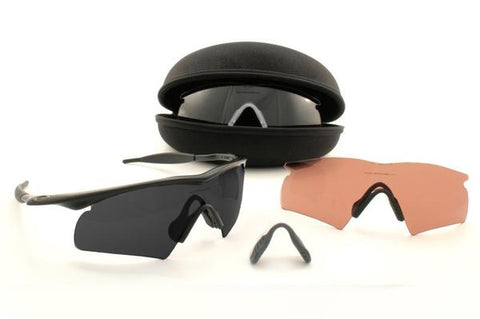Tactical Eyewear Buying Guide

As a professional in the armed forces or in your day to day work in law enforcement, you know there are certain essentials you need to get the job done. With injuries related to the eyes being a main concern for tactical professionals, having the right eyewear at the ready is key. With our tactical eyewear buying guide, find out the essentials of how to choose this necessity for your next mission or day on the job.
Why is it so crucial?
Eye injuries are a leading concern for tactical professionals. In fact, according to military.com, the budget proposed by Congress for the research and treatment of battlefield-related eye injuries has been increased in recent years from 4 million to a staggering 10 million dollars due to the overabundance of occurrences of this prevalent injury. The fact that eye injuries account for around 15% of all battlefield-related injuries, as well as the statistic that 75% of all traumatic brain injuries are accompanied by eye issues, it makes sense to focus on prevention of these injuries with the right eyewear options.
Range Versus Field
It is important to understand the environment you will be wearing the eyewear. While the matter of training at the range certainly requires safety measures for your eyes, you may not need something quite as intense as a pair intended specifically for military missions in the worst conditions. For example, a pair of glasses can meet the needs of UV reduction, reducing glares, and adding a protective barrier over eyes to resist impacts which is ideal for the range or on duty patrolling, but a pair of glasses for a military situation will need the extra consideration of dealing with high levels of wind, high temperatures, dust storms, and high impact blasts found in combat zones. Tactical glasses for the range or LEO purposes do not need to meet these needs necessarily. While it won’t do any harm for an LEO to utilize a military grade pair of eyewear at the range on the job, it can be detrimental for a military professional to use a pair not rated within the military guidelines listed above. Make sure you check for military grade ratings if you will be in the types of scenarios and situations calling for those specifications.
Safety Ratings
Since safety ratings play a role in finding the pair that is right for your needs, our tactical eyewear buying guide needs to cover a few basics you should know. It is important to note that you may see two different codes or safety ratings associated with different pairs of glasses since glasses can be classified as either tactical rated or ballistics rated. Ballistics rated is the common term for military grade glasses because they test for higher ballistics impacts than what is deemed necessary for LEO tactical eyewear.
The two ratings of ANSI and MIL PRF are often used interchangeably, but they meet different standards which you need to be aware of for protection to fit your exact needs. The general standards are tested by ANSI (American National Standards Institute) which tests projectiles at 150 fps to reach their impact resistant standards. However, the U.S. military requires testing projectiles at 650 fps for glasses to be considered suitable for military ballistics standards. With this guideline in mind, this will make it easier to navigate whether a pair has been tested to meet the needs of routine LEO needs or for military missions in more extreme environments and threats. For instance, a pair may have an ANSI rating, but not a MIL PRF rating which means it is not ballistic rated for military purposes. However, eyewear can also have both safety ratings for a more protective option.
The good news about buying within these ratings is that it takes some of the pressure off the decision-making process. Since these glasses are made with the highest standards in terms of matters such as durability of the frame and lenses, as well as performance matters such as glare reduction, UV ray protection at a high level, scratch resistant coating, fog reducing materials, and other matters of importance to a professional in need of reliable eyewear.
Lens Color
When it comes to the matter of specialized performance created specifically for the needs of tactical professional, the lens color is the key to mastering certain roadblocks that can get in the way of your shooting proficiency and performance overall. Here are the most commonly seen colors in tactical eyewear.
Gray
This is the most commonly color opted for since this color helps to reduce the amount of light from all directions and all tones which allows for the eyes to see a more balanced tone of color. This color lens is also best suited for bright conditions as well as helping to get a better sense of contrast and depth.
Amber
A popular choice for their ability to block blue-light and their capacitates in low light scenarios, amber lenses offer a similar contrast between colors similar to gray lenses. However, this option helps to make the orange of a target stand out. For this reason, this lens color is most commonly used in outdoor ranges during training sessions.
Yellow/Orange
Similar to amber because they help make the orange of a target more prominent, this color lens is great for target training. It has a higher rate of blocking out blue light which makes it ideal for cloudy days on the range or in the field. This color is also commonly used because it creates a more detailed line of vision that is easier to follow. This allows for better depth perception and improved accuracy making this a popular choice for both training and in fieldwork.
Brown
A common choice for their practicality in open areas of particularly bright sunlight, this color can create a soothing effect for the eye and a gentle color appearance to help reduce eye strain. It also helps with reducing distractions by focusing the eye which makes it a common choice for both the range and missions.
Purple/Blue
Ideal for outdoor shooting since they help to balance out greens, reducing visual distractions, and improving contrast overall, this is a popular choice for a range of needs. They are a solid solution for areas of high sunlight as well, since they help with color balance.
Sources
http://www.military.com/daily-news/2013/04/04/congress-budgets-10m-for-eye-injury-research.html
